As an Amazon Associate I earn from qualifying purchases.
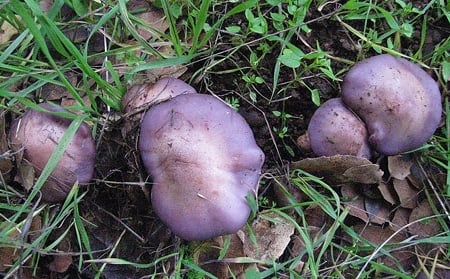
I present to you Lepista nuda, also known by the homey name blewit, which sounds like you just missed a great opportunity. And you would, if you passed up a chance to eat these mushrooms.
Blewits are a worldwide species (also known as Clitocybe nuda, with a cousin Lepista saeva in Europe) that likes trees and fallen leaves or other decomposing duff. It is pretty easy to identify and worth taking home, if only for the vivid lilac-to-lavender color.
I mentioned a few weeks ago that I walked right by some blewits on a recent mushroom foray. Yes, I “blewit.” But I made amends by returning to that spot a week later, where I picked 2 pounds in 15 minutes. I also found some blewits near Folsom Lake two days ago, so they are popping now.
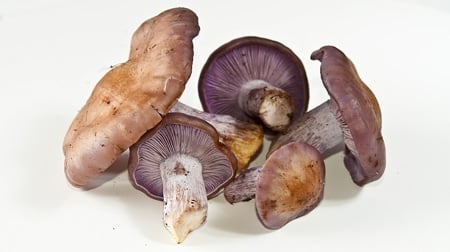
Here’s what you need to know about gathering blewits:
- They are, in general, a cool weather mushroom, arriving in the Northeast and Pacific Coast around October and persisting all winter long — so long as there are no extended frosts.
- Blewits have a standard “mushroom” shape: simple cap, a thick, stocky stalk, tight gills. There will be no ring or veil around the stalk.
- The cap should be smooth, almost suede-like. It will have leaf litter stuck to it from time to time, but it will never be slimy or viscid. Blewit caps are often beige to mauve. As the mushroom ages, the edges of the cap will get wavy.
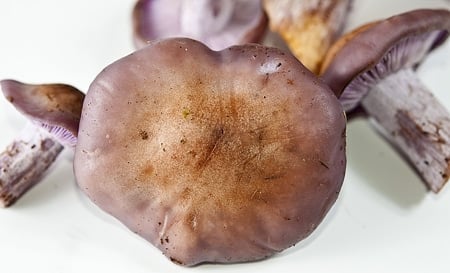
- Look for the lilac or lavender color underneath the cap. The color on a blewit is concentrated on the gills, although the cap and stalk will be a little purple, too. The gills are close together.
- Blewits like company, both their own and with other mushrooms. It is rare to find just one blewit, and they will often pop up in loose arcs or rings. Chanterelles are often around them, too.
- Here in California they seem to like to hang around oaks. But they can grow in any pile of decomposing stuff. Blewits will return year after year in the same spot if there is a fresh supply of litter, mostly fallen leaves.
- When you do a spore print — cut the cap off a mushroom and place it, gills down, on a white piece of paper — the spores should light in color, a whitish dull pink to pinkish beige. Their poisonous lookalike, the Cortinarius, has darker, rusty-colored spores.
- Blewits have a slight aroma, which I think smells like lilacs. David Arora in Mushrooms Demystified says they smell like frozen orange juice.
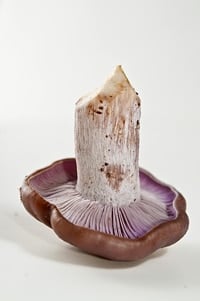
There are a few other blue-to-purple mushrooms around, but none that meet all these requirements. If you have a mushrooms with a suede-like cap, stocky stalk, tight, vivid purple gills, a slight but pleasant aroma and that has light, pinkish-tan spores, you have a blewit.
Just keep an eye out for purple mushrooms with “cobwebs” around the veil of the cap — those are cortinarius, which are mostly a toxic species.
Sadly blewits don’t merit the praise and adulation that chanterelles, porcini or morels do. I found no author who detailed the pluses and minuses of particular cooking methods, and only hints at what other foods go well with blewits. Shallots, butter and cream for certain. One author says they like anise flavors, like Pernod or fennel. Another says they don’t like garlic.
The one recipe I did find repeated in various ways was, of all things, an English one; the English are notoriously fungi-phobic. Yet I found lots of versions of a blewit and chicken pot pie. Sounded good to me.
Only I did not want to bother with a pie crust, and I thought I might sex up the standard recipe with some French touches: thyme, shallots and Armagnac. I also skipped the chicken and went right for some pheasant breasts I had in the freezer.
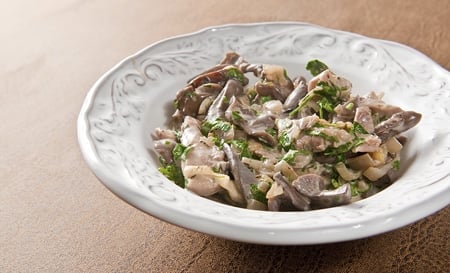
First thing I noticed is that blewits act a lot like the common cremini or button mushrooms you get in the store. They are thick, firm and full of water, which must be dry-cooked away before adding butter or oil. This is actually a good thing, because if you are not a mushroom hunter, you can easily substitute button mushrooms for blewits.
As a side note, the only thing you cannot do with blewits that you can with button mushrooms is eat them raw: Most sources say you must cook blewits before eating them. You won’t die if you eat raw blewits, but you will probably throw up and feel generally ill.
The second thing I noticed while cooking blewits was that despite what several authors say, they do not retain that lilac color when cooked. Or at least they didn’t after I dry cooked and then stewed them. Maybe they might keep the color if I gently steamed the mushrooms.
Third thing was in the eating. Blewits taste good enough — pretty standard mushroom flavor — but they can be a little slippery in texture. Not nasty-slimy-okra-slimy, just a little slippery. Took four or five bites to get used to it.
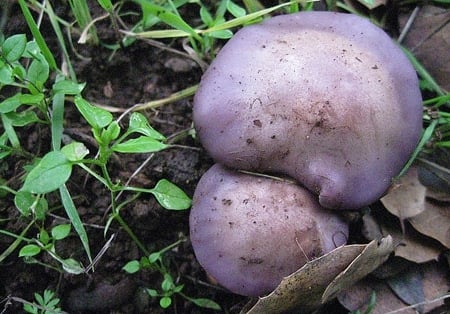
On the plus side, blewits are firm and chewy in a good way. It’s that squeaky, almost crunchy texture that you either love or hate with mushrooms. They can definitely stand on their own in a vegetarian dish, if you so desire.
For me, I loved the play between the texture of the mushrooms and the meaty pheasant breast, which is just gently cooked in cream and pheasant stock. And of course the butter, brandy, cream and shallots didn’t hurt, either. I’d make the recipe for blewit and pheasant again, and, if I chopped everything up small, I might even put it in a pie.

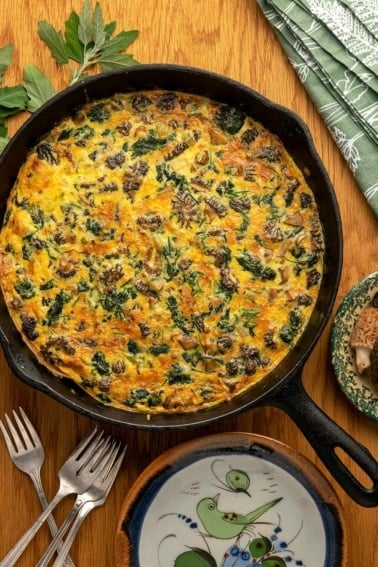
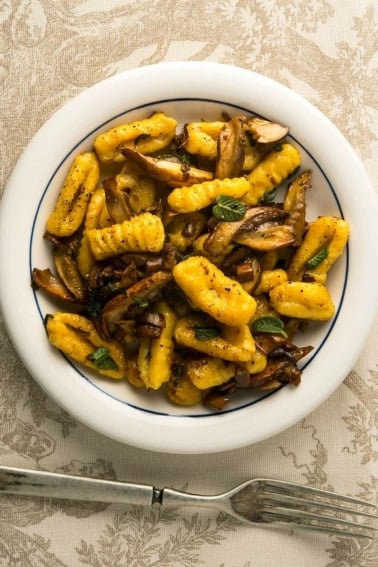


I poached my blewits in white wine together with leaks spring onions and cougets then baked them in the hot oven 180, with a Wensleydale and mustard toppind. I then grilled a pork steak to compliment the meal.
Absolutely delicious..
This is the best sounding recipe I’ve read to date. The mulch in my back yard exploded with a crop of blewits last fall late in the year. I’ve been hoping they restablish themselves while I look for a killer recipe. Thank you for sharing.
Very uninspiring, Blewit mushrooms have a quite unique flavour. Caramalise with onions and garlic and leeks, Add streaky smoked bacon sealed and bordering on crispy. Sprinkle a generous portion of groyere cheese on top and mustard powder and grill until brown ! Delicious.
One of the best ways to cook blewits is with sausage and bacon ,always bring to boil and simmer for minimum of 20 minutes eat as or blend to make lovely soup.
When the Blew it’s first start to grow are the the purple color and in the shape of an egg and can they be slimy as well?
Virginia: no.
I chopped up some home grown blewits and simmered them in red clam sauce for about a 1/2 an hour and had it over angle hair pasta. I loved it. I live in SC.
Where can I find purple mushroom kits to grow?
I am a seventy year old, and as a small boy I would go out on fosty autumn mornings to collect what we called blue stalks.
Best cooked in a white sauce with fried bacon on the side.
The old way in england is to fry with bacon bits add water and boil for 30mins then add cornflour mixed with a little milk and cook till thickened serve with crusty bread to mop up the gravy.
It sounds like the imposter is Laccaria amethystea-occidentalis or another species of the same genus. According to field guides they’re edible but lacking in flavor.
I have found Blewitts many times here in California under Oaks after a COLD rain in February. The flavor seems to gets stronger as the mushroom gets older and at some point becomes objectionable to me. Also, bugs and mold love them as they get older so best pick them when they are just breaking the veil and you can barely see them in the leaf litter. The nice color turns to a less appetizing grey as they cook but they do really wonderful in a cream/wine sauce or wild mushroom risotto.
You cannot honestly beat blewitts with egg and bacon for breakfast. Fry them in a little lard with a splash of water and cover for 15-20 minutes whilst grilling the bacon and frying the egg. To finish pore the gravy over and dunk your bread in. Wonderful.
Some people have mentionned a hollow stemed imposter– what is the proper name of the imposter? i have some Blewitts i found today, and the stems do seem hollow, and the gills more far spaced than some of the pictures i have seen . I am doing a spore print, but am wondering what imposter i should be comparing to? Thanks
My father was a poacher and gatherer of wild mushroms, also Blewits, which he alway’s called Bluey’s, he mostly cooked them in stews, rabbit,pheasant, partidge, with swede, parsnips carrots onions,shallots, I remember the lovely smell prior to serving was excelent.
I have Lepista Sordida (https://www.first-nature.com/fungi/lepista-sordida.php) in my garden, and they’re also edible when cooked. Nice flavour, very similar to Wood Blewits but usually with a curlier cap.
Enjoyed reading your post! It was the first one that came up when I goggled Blewits. Found some today, and am ready to try them out after I do a spore print to make sure that is what they are. But I think their fragrance gave them away. My first attempt at cooking them.
Tracey: “Gammon,” as in bacon made from the hind leg of a hog? Had to look that one up. And thanks for the tip! I will give that a go this winter.
In the Midland of England, Blewits are eaten with Gammon . Fry your Gammon steak first, then the “Blueys”, then make a gravy with the juices left in the pan. Lovely!
great mushrooms ….do not freeze them after cooking….bad,bad, taste
Speaking as an Englishwoman, I can assure you that the English are NOT funghi-phobic. Pretty much everyone I know regularly eats mushrooms of many varieties, some of the even grown their own. I have a few friends that get together and we go foraging together.
I think the myth we are funghi-phobic is one of those outdated stereotypes that needs to be filed along side stiff upper lips and all wear bowler hats 😉
Blewits make the v. best cream of mushroom soup; perfect for cold autumn/winter days.